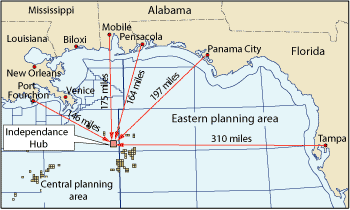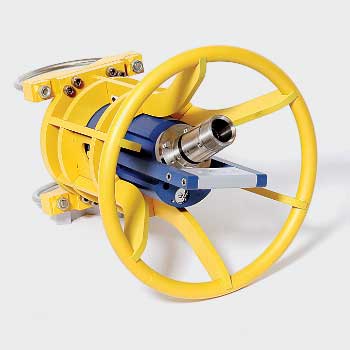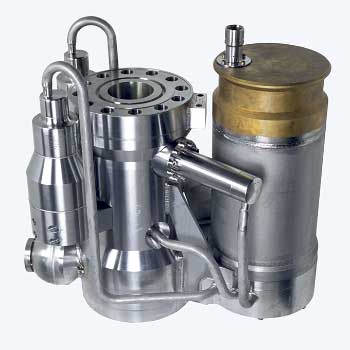Combining continuous, accurate-measurement saltwater detection and materials resilient in deepwater provides flow assurance and optimizes production for the multi-field project.
Alexis Houdusse, Roxar
With future demand for oil projected to grow by 42% and gas by 67% over the next 23 years,1 and more than 70% of the world’s oil and gas production coming from fields over 30 years old, operators are under pressure like never before to increase flow assurance and optimize production from existing fields.
Many subsea developments, however, are still not able to provide real-time well information critical to operators. Sometimes, production recovery for the same area with the same operator can be 15% lower in a subsea well compared to a similar topside well.
Too often, subsea production monitoring is based on approximations and poor and high-risk techniques, such as: testing through well reduction, with the dangers that the well might never be the same again; expensive subsea test lines or test separators; or relying on other downhole measurement instruments, such as flowrates, pressure drops and temperature distributions.
THE RISE OF DEEP, WET GAS FIELDS
There is an increase in offshore, deepwater wet gas fields-defined as being around 98-100% Gas Void Fraction (GVF).
The 2006 World Deepwater Market Forecast estimates that annual expenditures on deepwater operations will reach more than $20 billion by 2010, with deepwater gas production predicted to rise from 2.12 Tcfd in 2005 to 3.8 Tcfd in 2010.2
This growth in deepwater, wet gas fields has implications for flow assurance. Measuring accurate water production profiles is important to prevent rapid scaling from formation water reacting with MonoEthyleneGlycol (MEG), corrosion or well shutdown.
Water, especially saline water, can cause hydrates in the flow path that form from water and light hydrocarbons. The hydrates can block the flow path by forming in the wellbore, flowline, valves and meter discharges, and can cause rapid scaling as calcium carbonate from formation water reacts with MEG.
Multiphase transportation. Another challenge is the growth of multiphase transportation and commingling of unprocessed wellstreams, which raise partner and joint venture issues in sharing infrastructure, and also flow assurance issues, such as the risk of fluid incompatibility.
According to the Institute for Energy Technology, “multiphase pipeline transport cannot be exploited in a safe, controlled way unless the dynamic behaviour of the flow can be predicted with sufficient reliability.”3
Subsea tiebacks. Managing production costs and avoiding building production platforms have led to growth in subsea tiebacks that pipe untreated wellstreams over considerable distances to avoid construction of costly, offshore surface installations.
Without real-time water production measurements, it takes longer to detect a water breakthrough or sand buildup in the well, which, by the elapsed time, could lead to severe consequences and pipeline damage. Real-time water production profiles can allow remedial action to be taken as soon as the water is detected. Real-time information includes water saturation and possible breakthrough, gas coning, permeability and flow characteristics.
Multiphase meters will immediately detect a rising watercut, for example, through the change in the multiphase composition at the subsea wellhead. By examining the real-time information from downhole pressure and temperature gauges, the operator can gain a better understanding of where the problem originates, enabling rapid remedial action.
In the past, there was some skepticism toward the technology, but multiphase metering is now seen as a crucial tool in flow assurance. A recent report predicts the deployment of 1,000 additional multiphase meters by 2015.4
For all their benefits, however, traditional multiphase meters are not capable of detecting water to the accuracy and sensitivity rates required, as their performance gradually erodes when gas rates exceed 98% GVF.
In wet gas fields, water detection is critical when small amounts of saline water can lead to large and rapid scaling problems. For example, the desired water detection sensitivity for Ormen Lange Field is 0.005% by volume-a detection accuracy of 9 gal of water an hour in a 100-MMcfd well. Quite some accuracy!
INDEPENDENCE HUB
The Independence Hub Development, which came online in 2007, is an example of a field that faces all of the challenges already described. The development, a joint venture consisting of Anadarko Petroleum Corp. (who operates the Independence Hub platform), Eni, StatoilHydro and Devon Energy Corp., is located 185 mi southeast of New Orleans in Mississippi Canyon Block 920 in water depths of between 8,000 and 8,950 ft, Fig. 1. One of Independence Hub’s largest challenges is its 45-mi tieback.
 |
|
Fig. 1. Location of Independence Hub.
|
|
The development is also a highly complex structure with initial process production from fifteen wells made up of the Spiderman, San Jacinto, Jubilee, Vortex, Cheyenne, Merganser, Atlas, Atlas NW, Mondo NW and Q developments.
Measuring water production profiles and detecting sand. For a deepwater development with high pressure and high flowrates, accurately measuring the water production profile in wet gas wells is critical for optimizing production, preventing hydrate and scale in the pipelines and ensuring supply reliability.
According to Bob Buck, senior engineer for Worldwide Deepwater Operations, Anadarko: “Producing high gas fraction wells at these water depths requires the very best in flow assurance monitoring of individual fields and wells to ensure that hydrate formation does not affect production integrity.”
Detecting and reacting to sand in the well and flow stream was also crucial. Sand may clog production equipment, erode completion components, impede wellbore access, interfere with operation of downhole equipment and lead to wells being prematurely shut in or abandoned.
Decision-making criteria. The opeartor wished to conduct well testing without having to shut wells down. With each well producing 25-125 MMcfd, shutting down wells could be catastrophic and have a negative effect on production, as well as an inevitable drain on manpower and resources.
One alternative was to install a wet gas meter on a flowline, which would need to be between 10 and 14 mi long. However, the operator opted against this due to price and the requirement to shut down production. Multi-switched manifolds were also considered; however, they were deemed to not provide enough information from the wells in addition to having a high cost impact.
WET GAS METERS
The operator opted for the Roxar’s Wetgas meter for a number of reasons.
First, wet gas meters can continuously measure producing wells. The meter provides online and direct, accurate measurements of water in a wet gas flow. This functionality allows direct measurement of water at an early stage as soon as it starts to be produced from the well. The technology can also accurately detect saltwater coming into the wet gas stream, allowing Anadarko to distinguish between condensed water and formation water.
Accuracy of measurement was also important. The meter uses advanced microwave-based dielectric measurements to generate accurate gas and condensate flowrates based on standard delta pressure devices.
The meter, which has a typical length of less than 1 m, detects the resonant frequency in a microwave resonance cavity, with the resonant frequency depending on the dielectric properties of the fluid mixture present in the cavity. With permittivity of water (60-200) much higher than that of gas (about 1) or oil condensate (about 2), the dielectric properties of the wet gas mixture are very sensitive to the water content.
Performance tests show that the meter can detect changes in water production with sensitivity better than +0.005% volume, while absolute accuracy was +0.1% volume in high-GVF (> 99%) cases.
Furthermore, with 45-mi subsea tiebacks, there needed to be real-time measurement of water breakthrough, so that remedial action could be taken before lasting well or pipeline damage occurred.
Meters in operation. The meters were placed on jumpers (50 to 60 ft long) vertically after a blind “T.” The jumpers were at 7,500 to 8,000 ft of depth.
Robustness and resilience at such depths is essential. Externally, the wet gas meter, its Delta Pressure Transmitter (DPT) and Pressure Transmitter (PT) are constructed using duplex stainless steel that has an excellent combination of mechanical and corrosion-resistance properties, Fig. 2.
The meter is qualified to operate at 10,000 ft and within a process temperature range of -40-150°C, a process pressure range of 0-700 bars and maximum line pressure of 10,000 psi.
The operator installed an MEG regeneration system on the platform with MEG rates adjusted based on water production. The injection has, to date, been very low due to low water production.
The challenge was to obtain accurate water detection to adjust the MEG to be injected into the process. The first readings provided water production of 150 bbl of water for 60 Mcfd of gas, while the test separator readings were much lower. After calibration of the meters, the water content was 12 bbl a day, which was much closer to the readings given at the separator. The total MEG injection per day to prevent hydrate formation is around 50 bbl.
Continuous, real-time and accurate measurements were crucial. By measuring the early onset of formation-water production in real time, the opeartor can now take preventative or remedial action, such as adjusting the pH in the MEG/water mixture, optimizing MEG injection to each well for hydrate mitigation, injecting the right amount of corrosion inhibitor or, in the most extreme scenarios, choking the well or instigating zonal isolation.
Nikhil Joshi, who manages Roxar meters for Anadarko, said:
“By continuously measuring formation-water production from each well, Anadarko is able to operate it optimally and ensure hydrate mitigation is done using appropriate MEG injection. As a result, well shut-ins and downtime are reduced significantly and changes to the well performance are detected early for possible corrective measures.”
Also, the wellstreams are complicated by Vortex Field having a 25-mi tieback directly into the Jubilee-Cheyenne flowline, and by San Jacinto Field having a 22-mi tieback tied into Spiderman. The consequence of not developing water production profiles in long tiebacks would be unacceptable with an over-injection of chemicals and a potential loss of control over the long-distance systems.
Royalty allocation issues. Another challenge that the wet gas meters may address in the future is the issue of royalty allocation.
The Mineral Management Service (MMS), which regulates measurement of natural resources, has the responsibility to ensure that measurement and allocation procedures are both equitable and accurate. While the MMS usually asks the operator to have a topside measurement for allocation purposes, it granted an exception to Anadarko because of the wet gas meters on each well. MMS now checks the well tests every month.
When it comes to allocation, the partners perform a calculation every day or day and a half. With its continuous measurement requirements, Roxar’s meter was the only suitable technology to do this.
With 10 field developments-many with different ownership interests and royalty rates-accuracy is essential to ensure that production revenue streams are split correctly between partners.
Sand monitoring. The latest in sand-monitoring technology also has a crucial role to play at Independence Hub. In the past, sand monitoring tended to be slightly crude in nature and not always directed specifically to the amount of sand. Often, information on flowrate, watercut, pressure drops and temperature distributions were seen as possible means of measuring sand production as well as drawdown management-the difference between average reservoir pressure and flowing bottomhole pressure and production rate control.
With these inexact measurements came inevitable risks, including ignoring sand buildup that could lead to the loss of the well or overreaction to the existence of sand and subsequent unnecessary reduction or shutting down of production.
New sand monitoring devices on Independence Hub are capable of providing an early warning system that is an immediate response when sand is present, with the ability to check the integrity of sand screens set up to avoid sand entering production tubing.
One of the most significant technological developments in sand monitoring is how user-friendly it has become to install detectors. Sand detectors are either intrinsic, requiring installation in the fluid flow path, or clamp-on-type devices installed externally to the pipe. Detectors are ultra-compact and can be mounted in fixed, pre-installed clamps on the outside of pipe, which is useful when considering the deep waters and potentially inhospitable conditions in the Gulf of Mexico, Fig. 3.
 |
|
|
Ultra-sensitive acoustics and monitoring technology are capable of determining both the amount of sand in the wellstream and the acceptable sand production rate that the facilities can handle to a high degree of accuracy. By having accurate data on the amount of sand in the pipeline, production engineers on Independence Hub can minimize erosion damage, optimize production flowrates and prevent equipment clogging, and also, if necessary, look to remedial actions, such as sand cleanouts or a sand bailer.
CRUCIAL ROLE IN DECISION MAKING
Wet gas meters are providing data continuously and accurately in Independence Hub. Water breakthrough is also planned, with the operator providing a range of times when water breakthrough can occur. There have been no threats to the production so far.
As a result, the operator is able to exploit each well aggressively at the limit of its water production. The result will be fewer wells required in the reservoir, greater efficiency from those already there and increased production
With offshore shallow-water production in decline, many of the recent discoveries have been in deepwater fields. At such depths, high pressure and flowrates, with wells and pipelines highly vulnerable to sand and unchecked water, wet gas metering and sand monitoring are likely to play an ever-more-crucial role in the future. As Nikhil Joshi says:
“The improvements in these technologies are ensuring that the topside/subsea information gap is narrowed and that deepwater operations, such as the Independence Hub, can operate at the very peak of their production limits. We look forward to meeting and mitigating our flow assurance challenges for many years to come.” 
LITERATURE CITED
1 US Energy Information Administration.
2 “The World Deepwater Market Forecast 2006-2010,” Douglas-Westwood, 2008.
3 Thomassen, D., “Flow assurance,” Institute for Energy Technology, Aug. 8, 2007, http://www.ife.no/main_subjects_new/petroleum_research/flowas?set_language=en&cl=en.
4 “Subsea Processing Gamechanger Report 2006-2015,” Douglas-Westwood Limited and OTM Consulting, 2006.
|
THE AUTHOR
|
|
|
Alexis Houdusse is deputy commercial manager for subsea gas reservoirs at Roxar in Stavanger, Norway. He is working closely on the Independence Hub project. Mr. Houdusse joined Roxar in September 2006 after working in his native France in the nautical and industrial sectors. He graduated from the French business school ESDES with distinction.
|
|
|






